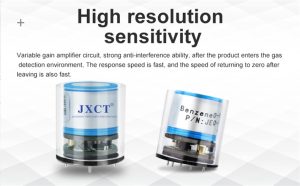Air pollution is a major global environmental issue that poses a serious threat to human health and the environment. It is caused by a variety of sources, including industrial emissions, vehicle exhaust, and agricultural activities. The World Health Organization estimates that air pollution causes 7 million premature deaths worldwide each year. In addition to its impact on human health, air pollution also contributes to climate change and environmental degradation.

One of the key tools in the fight against air pollution is the use of gas sensors to detect and monitor air quality. Gas sensors are devices that can detect the presence of specific gases in the air, such as carbon monoxide, nitrogen dioxide, and ozone. They are used in a wide range of applications, including environmental monitoring, industrial safety, and indoor air quality testing.
Gas sensors work by detecting the presence of a target gas through a chemical reaction that produces an electrical signal. This signal is then measured and analyzed to determine the concentration of the gas in the air. There are several different types of gas sensors, including electrochemical sensors, semiconductor sensors, and infrared sensors, each with its own strengths and limitations.
One of the key advantages of gas sensors is their ability to provide real-time data on air quality. This allows for the rapid detection of pollution events and the implementation of timely interventions to mitigate their impact. For example, gas sensors can be used to monitor emissions from industrial facilities and power plants, allowing for the early detection of leaks and malfunctions. They can also be used to monitor air quality in urban areas, helping to identify pollution hotspots and inform public health interventions.
In addition to their role in monitoring air quality, gas sensors can also be used to mitigate air pollution. For example, they can be integrated into ventilation systems to control the flow of outdoor air into indoor spaces, helping to reduce exposure to harmful pollutants. They can also be used in air purification systems to remove pollutants from the air, improving indoor air quality.
The use of gas sensors to detect and mitigate air pollution is a rapidly growing field, with new developments and applications emerging on a regular basis. One exciting area of research is the development of low-cost, portable gas sensors that can be deployed in a wide range of settings, including homes, schools, and public spaces. These sensors have the potential to revolutionize our ability to monitor and address air pollution, providing individuals and communities with the tools they need to protect their health and the environment.
Another area of innovation is the integration of gas sensors into smart city infrastructure. By deploying networks of gas sensors throughout urban areas, cities can gain real-time insights into air quality and develop targeted interventions to address pollution hotspots. This approach has the potential to transform the way we think about urban planning and public health, empowering cities to create healthier and more sustainable environments for their residents.
Despite their potential, the use of gas sensors to detect and mitigate air pollution is not without its challenges. One of the key issues is the need for accurate and reliable sensors that can provide precise measurements of air quality. This requires ongoing research and development to improve sensor technology and ensure that it meets the needs of diverse applications and environments.

Another challenge is the need for effective data analysis and interpretation. Gas sensors generate large amounts of data, and it can be challenging to extract meaningful insights from this information. This requires the development of advanced data analytics tools and algorithms that can process and interpret sensor data in real time, allowing for rapid decision-making and intervention.
In conclusion, gas sensors are a powerful tool for detecting and mitigating air pollution. They provide real-time data on air quality, allowing for the rapid detection of pollution events and the implementation of timely interventions. They also have the potential to mitigate air pollution through their integration into ventilation and air purification systems. As research and development in this field continue to advance, gas sensors have the potential to revolutionize our ability to monitor and address air pollution, creating healthier and more sustainable environments for all.
 : +86 155 8830 2704
: +86 155 8830 2704 : jxdziot@gmail.com
: jxdziot@gmail.com
